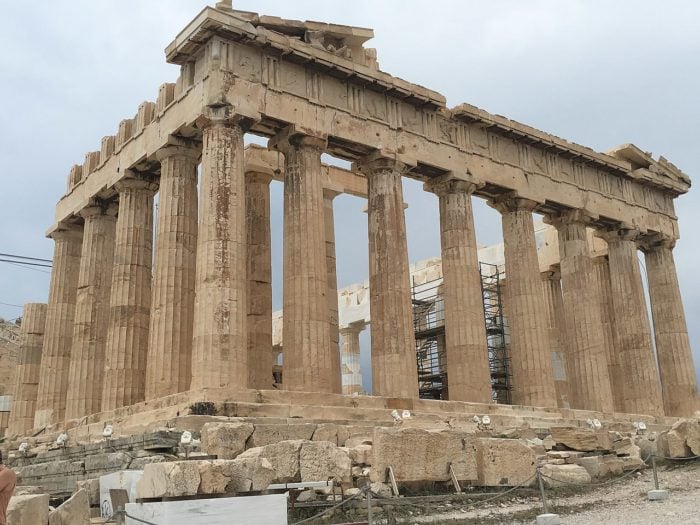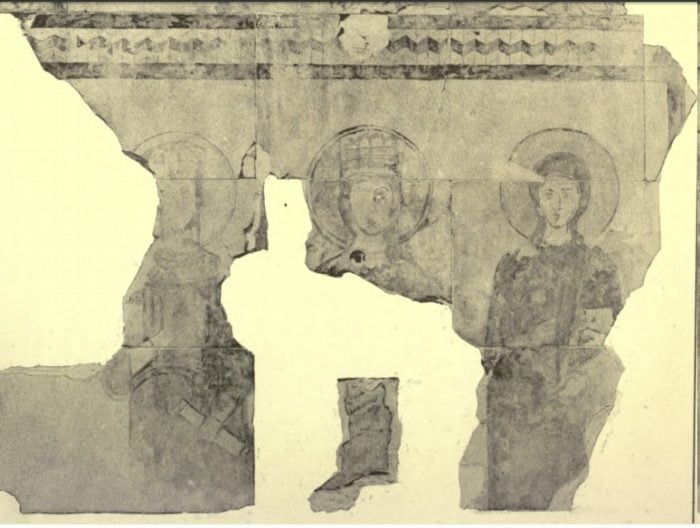
The brightest symbol of Western Civilization, the Parthenon of Acropolis, was converted to a Christian church for almost a millennium from 500 AD to 1450.
Originally built in 432 BC to honor Athena Parthenos, the Greek goddess of wisdom and war, the magnificent Parthenon has seen several changes.
In 500 AD, when Christianity was established in the eastern part of the Roman Empire, the temple of Athena became the temple of Panagia Athiniotissa (Virgin Mary the Athenian).
Soon, the temple and the Acropolis hill became a Christian pilgrimage center of great importance throughout the history of Byzantium.
Pilgrims from all over Greece and and the Orthodox world flocked to Acropolis as pilgrims to the Virgin Mary.
A smooth conversion
One of the most interesting points of the conversion of the ancient temple to a Christian one is that there were no radical changes in its exterior.
The pediments were not covered but left as is. The fear of the “demonic” ancient gods, apparently did not include the Acropolis. It seems the Christians showed their respect for this historical monument.
However, the interior of the nave and parts of the columns were severely damaged by fire (perhaps due to the invasion of Athens in 267 AD) or from an earthquake.
In the 5th century, the Parthenon was transformed into a three-aisled Christian basilica dedicated first to Hagia Sophia and then (in the mid-Byzantine years) to Panagia Athiniotissa.
During the reign of Emperor Justinian, however, it was consecrated and defined as the “Catholic Church of Athens.”
An anonymous 15th-century manuscript in the Vienna Library states that “the temple of Our Lady on the Acropolis was built by Apollo and Euligius,” who were contemporaries of Justinian and Tiberius II, respectively.
From the end of the 6th century onwards, the dead of the clergy, bishops, and others began to be buried around the church. Excavations in 1836 found many monuments of a Christian cemetery.
Furthermore, a marble inscription, as well as bronze coins of emperors Justinian and Justinian II and some gold coins of Tiberius II of Thrace, were discovered in regard to “the holiest church of Athens.”

The Parthenon of Acropolis decorated as a Christian church
Gradually, the temple of Panagia Athiniotissa was decorated with icons, mosaics, and Byzantine frescoes.
The eastern entrance of the ancient sanctuary was closed, and the pronaos that became the holy step was raised one step above the old ground.
The altar was covered with Pentelic marble and rested on four small porphyry columns with marble and gilded Corinthian columns. Above it hung a golden dove representing the Holy Spirit.
Two smaller ones were built in the sanctuary to the north for the presentation of the sacred gifts while to the south was the sacristy in which the sacred vessels, vestments, and liturgical books were deposited.
At the bottom of the arch and in the middle of the semicircular platform rose the episcopal marble throne.
The ancient rear building was transformed into a narthex of the church, which was connected to the nave by a door while the church was filled with frescoes.
The old and wide entrance was preserved as a large gate. Elsewhere, stood columns of jasper.
There was also a pulpit and a bell tower, which protruded from the wooden roof of the basilica and rested on the nave of the temple of the Virgin Athena.
The golden image of the Virgin Mary stood in a niche above the sanctuary, adorned with thousands of psyches, the so-called gold stones.
On the rear walls, faint relics of Byzantine icons are preserved to this day. In this church, a lime lamp was burning, which has existed in the temple since ancient times. Pausanias mentions that it burned in front of the statue of Athena.

The Acropolis’ Parthenon is converted to a mosque
After the brief conquest of Byzantium by the Crusaders during the Fourth Crusade (1204), the Parthenon Christian church was looted and then converted into a Catholic church under the name “Santa Maria di Atene.”
Later on when the rule of Athens was under the ducal De la Roche family, the church was dedicated to Notre Dame, and a high bell tower was built in its southwest corner.
After the fall of Athens to Ottoman hands under Mohammed II the Conqueror in 1458, the Parthenon was turned into a mosque and the Frankish bell tower into a minaret.
Despite the occasional changes and damage it suffered, the building maintained its architectural coherence and most of its plastic decoration until the 17th century.
It was not until 1687 in the middle of the Second Venetian-Turkish War that a shell from Morosini’s artillery fell on the Parthenon where the Turks had set up a gunpowder depot, causing the temple to explode along with extensive damage to its sculptural decoration.
For centuries, the Christians believed The Virgin Mary, Our Lady, protects her faithful much like goddess Athena protected the Athenians through every one of life’s difficult moments.
See all the latest news from Greece and the world at Greekreporter.com. Contact our newsroom to report an update or send your story, photos and videos. Follow GR on Google News and subscribe here to our daily email!



